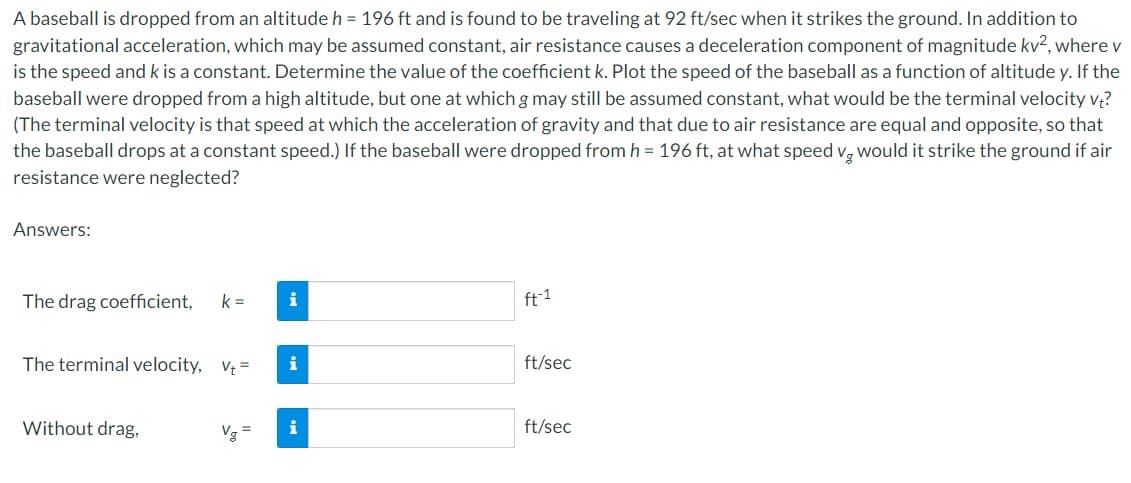A baseball is dropped from an altitude h = 196 ft and is found to be traveling at 92 ft/sec when it strikes the ground. In addition to gravitational acceleration, which may be assumed constant, air resistance causes a deceleration component of magnitude kv², where v is the speed and k is a constant. Determine the value of the coefficient k. Plot the speed of the baseball as a function of altitude y. If the baseball were dropped from a high altitude, but one at which g may still be assumed constant, what would be the terminal velocity v? (The terminal velocity is that speed at which the acceleration of gravity and that due to air resistance are equal and opposite, so that the baseball drops at a constant speed.) If the baseball were dropped from h = 196 ft, at what speed vg would it strike the ground if air resistance were neglected? Vg Answers: The drag coefficient, k= i The terminal velocity, Vt= Without drag, i i ft-1 ft/sec ft/sec
A baseball is dropped from an altitude h = 196 ft and is found to be traveling at 92 ft/sec when it strikes the ground. In addition to gravitational acceleration, which may be assumed constant, air resistance causes a deceleration component of magnitude kv², where v is the speed and k is a constant. Determine the value of the coefficient k. Plot the speed of the baseball as a function of altitude y. If the baseball were dropped from a high altitude, but one at which g may still be assumed constant, what would be the terminal velocity v? (The terminal velocity is that speed at which the acceleration of gravity and that due to air resistance are equal and opposite, so that the baseball drops at a constant speed.) If the baseball were dropped from h = 196 ft, at what speed vg would it strike the ground if air resistance were neglected? Vg Answers: The drag coefficient, k= i The terminal velocity, Vt= Without drag, i i ft-1 ft/sec ft/sec
College Physics
11th Edition
ISBN:9781305952300
Author:Raymond A. Serway, Chris Vuille
Publisher:Raymond A. Serway, Chris Vuille
Chapter1: Units, Trigonometry. And Vectors
Section: Chapter Questions
Problem 1CQ: Estimate the order of magnitude of the length, in meters, of each of the following; (a) a mouse, (b)...
Related questions
Concept explainers
Topic Video
Question
box the final answer

Transcribed Image Text:A baseball is dropped from an altitude h = 196 ft and is found to be traveling at 92 ft/sec when it strikes the ground. In addition to
gravitational acceleration, which may be assumed constant, air resistance causes a deceleration component of magnitude kv², where v
is the speed and k is a constant. Determine the value of the coefficient k. Plot the speed of the baseball as a function of altitude y. If the
baseball were dropped from a high altitude, but one at which g may still be assumed constant, what would be the terminal velocity vt?
(The terminal velocity is that speed at which the acceleration of gravity and that due to air resistance are equal and opposite, so that
the baseball drops at a constant speed.) If the baseball were dropped from h = 196 ft, at what speed vg would it strike the ground if air
resistance were neglected?
Answers:
The drag coefficient, k=
The terminal velocity, Vt=
Without drag,
i
i
i
ft-1
ft/sec
ft/sec
Expert Solution
This question has been solved!
Explore an expertly crafted, step-by-step solution for a thorough understanding of key concepts.
Step by step
Solved in 6 steps with 6 images

Knowledge Booster
Learn more about
Need a deep-dive on the concept behind this application? Look no further. Learn more about this topic, physics and related others by exploring similar questions and additional content below.Recommended textbooks for you

College Physics
Physics
ISBN:
9781305952300
Author:
Raymond A. Serway, Chris Vuille
Publisher:
Cengage Learning

University Physics (14th Edition)
Physics
ISBN:
9780133969290
Author:
Hugh D. Young, Roger A. Freedman
Publisher:
PEARSON

Introduction To Quantum Mechanics
Physics
ISBN:
9781107189638
Author:
Griffiths, David J., Schroeter, Darrell F.
Publisher:
Cambridge University Press

College Physics
Physics
ISBN:
9781305952300
Author:
Raymond A. Serway, Chris Vuille
Publisher:
Cengage Learning

University Physics (14th Edition)
Physics
ISBN:
9780133969290
Author:
Hugh D. Young, Roger A. Freedman
Publisher:
PEARSON

Introduction To Quantum Mechanics
Physics
ISBN:
9781107189638
Author:
Griffiths, David J., Schroeter, Darrell F.
Publisher:
Cambridge University Press

Physics for Scientists and Engineers
Physics
ISBN:
9781337553278
Author:
Raymond A. Serway, John W. Jewett
Publisher:
Cengage Learning

Lecture- Tutorials for Introductory Astronomy
Physics
ISBN:
9780321820464
Author:
Edward E. Prather, Tim P. Slater, Jeff P. Adams, Gina Brissenden
Publisher:
Addison-Wesley

College Physics: A Strategic Approach (4th Editio…
Physics
ISBN:
9780134609034
Author:
Randall D. Knight (Professor Emeritus), Brian Jones, Stuart Field
Publisher:
PEARSON